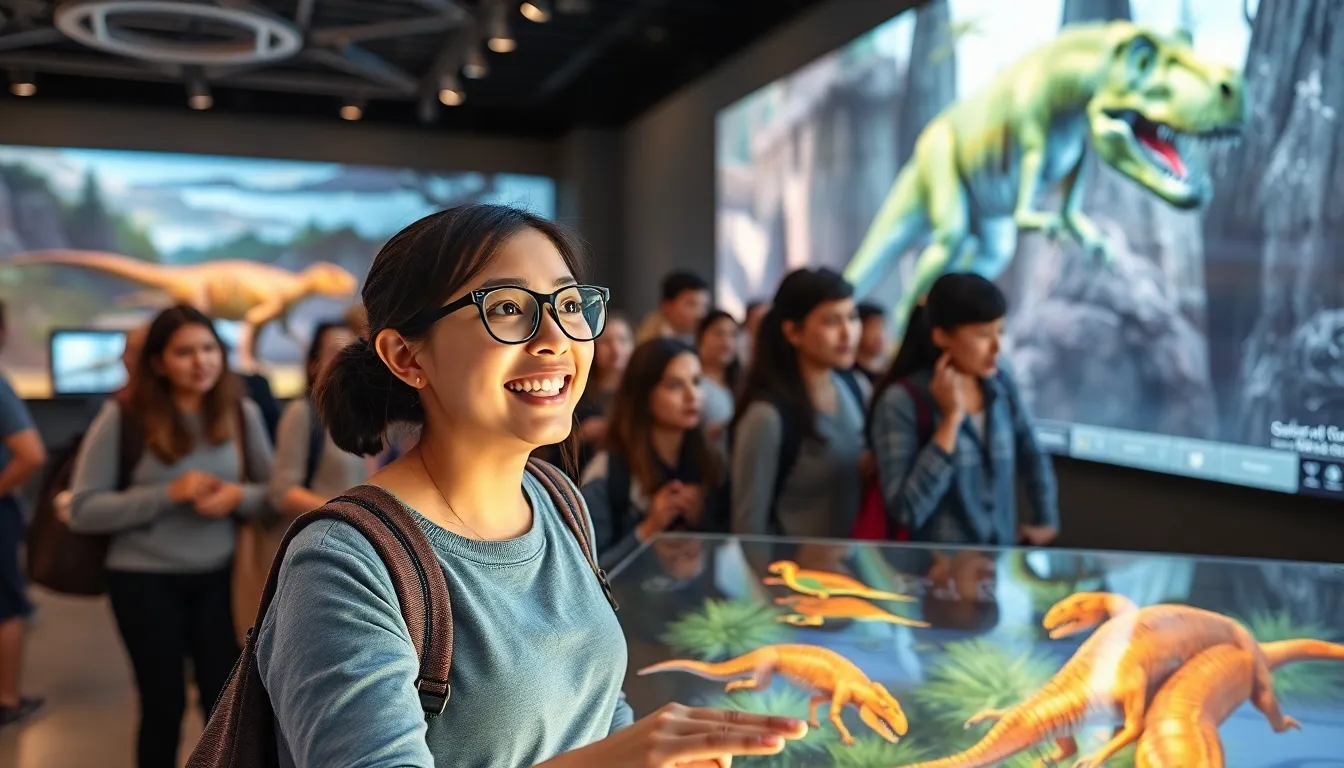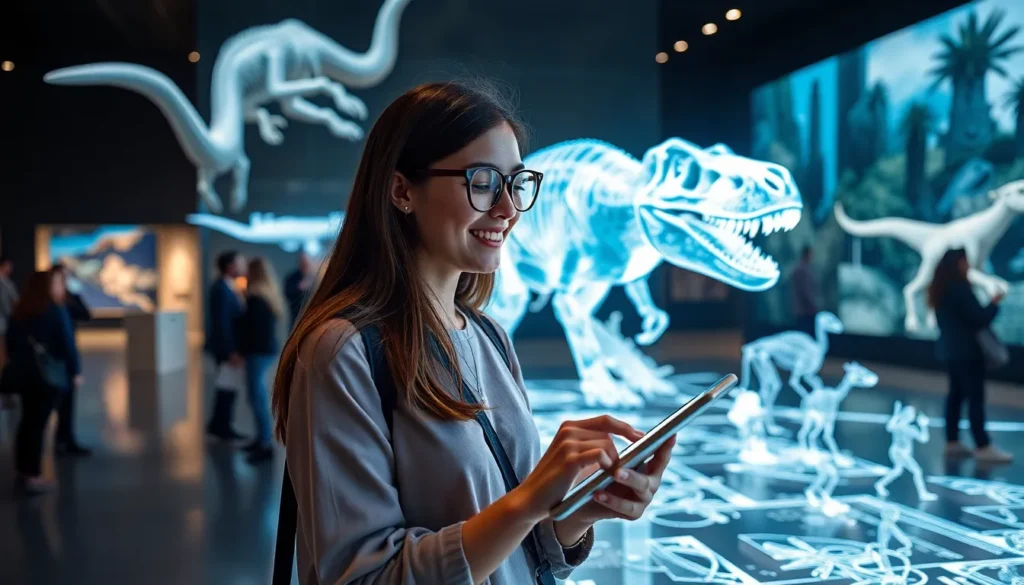Table of Contents
ToggleImagine stepping into a museum where the exhibits come to life, and history leaps off the walls. Welcome to the world of augmented reality museums, where art and technology shake hands and invite you to join the party. Gone are the days of staring at dusty artifacts behind glass; now, visitors can interact with their favorite pieces in ways that are both entertaining and educational.
Overview of Augmented Reality Museums
Augmented reality museums enhance visitor engagement by integrating digital technology with physical exhibits. These spaces allow guests to experience art, history, and science through interactive displays and virtual elements. The combination of physical artifacts with digital information creates a multifaceted learning environment.
Visitors often use smartphones or tablets to view augmented content. Among the popular features are 3D models, animations, and audio guides that provide deeper insights into the exhibits. Each interaction helps visitors grasp complex concepts and stories behind the artifacts.
Several augmented reality museums focus on specific themes. For example, the British Museum in London offers an AR app that allows users to visualize long-gone treasures. In addition, the Smithsonian national museum showcases historical scenes through augmented overlays that bring the past to life.
The technology behind these museums continues to evolve. Developers implement state-of-the-art applications for more immersive experiences. As the technology improves, museums become more accessible and engaging for diverse audiences.
User experience is central to augmented reality museums. Engaging elements encourage visitors to explore and discover new information. Educational institutions also benefit, as children can learn through interactive displays, solidifying their knowledge in a fun way.
Innovations in augmented reality are likely to shape museums in the future. The trend emphasizes creating memorable experiences that encourage repeat visits. With each passing year, augmented reality museums redefine how society interacts with cultural and historical narratives.
Benefits of Augmented Reality Museums

Augmented reality museums offer significant advantages that enhance the overall visitor experience and educational value.
Enhanced Visitor Experience
Interactions in augmented reality museums captivate visitors and foster deeper engagement with exhibits. Digital overlays and immersive elements breathe life into artifacts, transforming how guests perceive history and art. Unique features—such as 3D models and interactive animations—permit visitors to explore details not visible with the naked eye. Smartphone and tablet accessibility provides flexibility, allowing users to engage on their own terms. Such dynamic experiences encourage prolonged visits and promote curiosity about the presented topics.
Educational Opportunities
Augmented reality museums revolutionize learning through interactive educational tools and resources. Guests can access context-rich information that deepens their understanding of exhibits. Engaging audio guides and informative videos complement physical displays, making complex subjects more digestible. Furthermore, augmented reality enhances storytelling, creating memorable narratives that resonate with diverse learning styles. This approach fosters critical thinking and analytical skills by inviting users to question and explore realistic simulations of historical events or scientific concepts.
Popular Augmented Reality Museums
Augmented reality museums uniquely blend technology with artifacts, creating memorable educational experiences. Two notable examples illustrate the potential of this innovation.
Case Study: The Museum of Other Realities
The Museum of Other Realities offers a groundbreaking virtual platform for immersive art experiences. Visitors can explore a vast array of digital artworks through augmented reality, enhancing their understanding of contemporary art. Interactive exhibits encourage engagement, allowing guests to manipulate and interact with virtual pieces. Each interaction reveals layers of creativity not easily accessible in traditional settings. This museum showcases how AR technologies redefine the art viewing experience.
Case Study: The Louvre Abu Dhabi
The Louvre Abu Dhabi merges cultural heritage and cutting-edge technology to create a unique visitor experience. Its augmented reality app guides users through the museum with detailed virtual enhancements. Attendees access contextual information about each artwork, deepening their appreciation of diverse collections. Additionally, the app features 3D models that bring historical pieces to life. Visitors gain insights into the stories behind the artifacts, enriching their overall understanding of art history.
Challenges Facing Augmented Reality Museums
Augmented reality museums face several challenges that impact their development and overall effectiveness. Addressing these obstacles is crucial for maximizing visitor engagement and enhancing educational experiences.
Technology Limitations
Technology limitations present significant hurdles. Current AR applications often rely on high processing power, which many mobile devices don’t support. Moreover, inconsistencies in AR software performance can lead to negative experiences, deterring visitors from exploring further. The need for reliable internet connectivity adds another layer of complexity, as many areas within museums may not provide extensive Wi-Fi access. Additionally, battery life issues can interrupt immersive experiences, leaving users frustrated. Developing robust applications that function smoothly across a variety of devices remains essential for improving the overall visitor experience.
Accessibility Issues
Accessibility issues hinder the reach of augmented reality museums. Many visitors may lack the necessary technology, such as smartphones or tablets. Economic factors also play a role, as individuals may not prioritize spending on devices for museum visits. Language barriers can create challenges in understanding AR content, alienating non-native speakers. Furthermore, visitors with disabilities may find it challenging to use AR applications without proper accommodations. Ensuring that AR experiences are inclusive and accessible to all audiences requires ongoing attention to user interface design and content delivery methods.
Future Trends in Augmented Reality Museums
Augmented reality museums are set to evolve significantly in the upcoming years. Advancements in AR technology promise an even richer user experience that combines the physical and digital realms seamlessly. Virtual reality (VR) integration may further immerse visitors in historical contexts, offering an unparalleled depth of understanding.
Interactivity will continue to play a crucial role in these museums. More sophisticated interfaces can engage users at multiple levels, allowing hands-on learning experiences that captivate diverse audiences. Real-time feedback mechanisms could enhance the educational value, ensuring visitors grasp complex concepts effectively.
Mobile application use is likely to expand as more museums adopt augmented reality features. By utilizing smartphones and tablets, institutions can reach wider demographics, making cultural experiences more accessible. Innovative partnerships with tech companies will bring forth cutting-edge applications that enhance the visitor journey.
Sustainability trends are also emerging in the realm of augmented reality. Museums may adopt eco-friendly technologies and practices that lessen their environmental footprint. Digital features can mitigate the need for physical materials while simultaneously attracting eco-conscious visitors.
Data analytics will increasingly shape personalized experiences. By collecting information on visitor interactions and preferences, museums can tailor content to specific interests, boosting engagement rates. Understanding visitor behavior through analytics could lead to more effective exhibit designs.
Finally, continuous investment in staff training and technology maintenance is essential. Ensuring museum personnel are well-versed in AR tools enhances visitor assistance and enriches educational experiences. As museums embrace these trends, they become pivotal in shaping how individuals connect with cultural narratives.
Augmented reality museums represent a groundbreaking shift in how individuals engage with art and history. By blending digital technology with physical exhibits, they create immersive experiences that captivate and educate visitors. As these museums continue to evolve, they promise to redefine cultural interactions and enhance learning opportunities.
The future of augmented reality in museums looks bright. With advancements in technology and a focus on accessibility, these spaces are set to become even more engaging and inclusive. As they tackle existing challenges and embrace innovative trends, augmented reality museums will undoubtedly enrich the way society connects with its cultural heritage.







